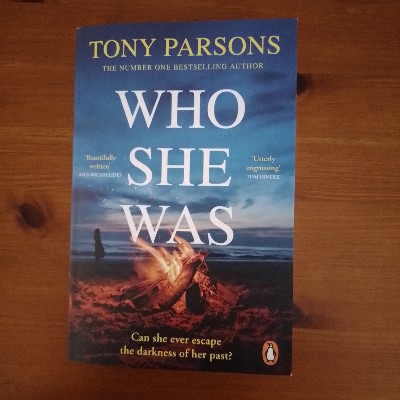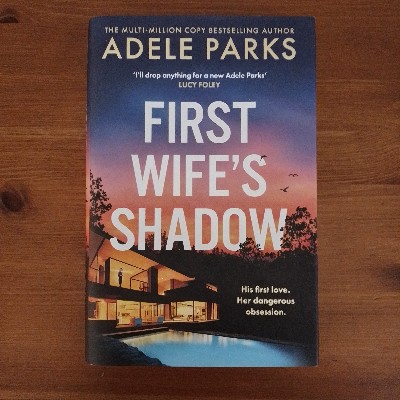Who She Was and First Wife's Shadow - Book recommendations for August 2024
August is the time to take things easy, enjoy a holiday, and have plenty of time to sit in the sun and read some great books. We can't guarantee the sun, but we do have two super books to recommend for your Summer reading.
As we have mentioned before, it is incredible how often Daphne du Maurier is linked in some way with other writers books, and, of course, because this is the Daphne du Maurier website, the books I have chosen to tell you about today, came to me because they both have a Daphne du Maurier connection, although each in an entirely different way to the other.

An image of the front cover of the new paperback edition of Who She Was by Tony Parsons
My first book recommendation is Who She Was by Tony Parsons. Tony is a well-known and hugely successful journalist, broadcaster and author, possibly most famous for his 1991 novel Man and Boy and his DC Max Woolfe series. He has also written many stand-alone novels, of which Who She Was is the latest, published in hardback in 2023 and in paperback in April of this year.
During a recent interview at the Foreign Correspondents Club in Hong Kong, Tony said that he had long-held memories of Cornwall from childhood, and during the pandemic, when travel abroad was virtually impossible, he fell in love with Cornwall all over again. He pointed out that a lot of the best British writing comes from Cornwall, including some of John Betjeman's finest poetry, the works of Daphne du Maurier, and Winston Graham's Poldark novels. He thinks Cornwall is a great place for storytelling because of the tension there, and he came up with a great analogy of what he meant by this, saying :
In Cornwall, there are those who catch the lobsters and those who eat the lobsters!
Living in Cornwall, I can understand just what he means. The sentence will also make perfect sense when you read Who She Was because one of the characters owns a Lobster Restaurant, and some of the other characters in the novel work at the restaurant with him.
Who She Was is clearly influenced by Daphne du Maurier and Tony's love of Cornwall. The novel is set mainly on the south coast in a village with a small, tight-knit community, which is disrupted by the arrival of a young woman called Clementine, who is found sitting on the beach in the middle of the night, keeping herself warm by a small fire that she has made from an old broken deckchair.
Clementine is taken into the hearts of the villagers and made to feel welcome, but she may not be who she seems. In fact, more than one person in the village may not be who they seem. The plot twists and turns, and the narrative is interspersed with extra detail and opinions from the various characters in the story. This clever ploy does mean that there is never a moment when you feel you can put the book down and do something else because the story compels you just to keep reading!
Yes, this book is utterly unputdownable, which, for me, is a sign of an excellent piece of storytelling. So, not only did Daphne du Maurier, and particularly her Cornish novels, influence Tony in his writing of Who She Was, she also gets several mentions in the novel. For example, in chapter 23, DCI Graves interrupts the story with some pearls of wisdom, saying:
…Because people in this county are a bit different to everyone everywhere else. And they always have been. Read "Jamaica Inn". Read "Frenchman's Creek". Read "Rebecca", for God's sake. Daphne du Maurier will explain it to you better than I ever could.
The book includes lots of references to Daphne du Maurier; here's another one, again it's DCI Graves speaking:
…' and I quite fancy retiring down here, finding the places that Daphne du Maurier based her books on. The real cove in "Rebecca". The moors in "Jamaica Inn". The secret river in "Frenchman's Creek" where the woman lay with her pirate lover.' She laughed a little embarrassed, 'Does that sound silly? You see I never married, never had kids. None of that ever happened. I had an experience as a young woman that put me right off all that caper. It was – well, let's say it never happened. So, looking for Daphne du Maurier – that's the plan once we have tied all this up.'
There is one more thing that tells me that Daphne du Maurier's influence is a powerful force in Who She Was, and that is the fact that the opening chapter and the final chapter mirror one another, so you really do come full circle in reading this novel. This is a device Daphne used in several of her novels.
The first example of this in Daphne's work is in the novel The Progress of Julius, which opens with the line:
His first instinct was to stretch out his hands to the sky.
and the closing sentence of the novel is:
His last instinct was to stretch out his hands to the sky.
A more well-known example comes in My Cousin Rachel when Daphne opens and closes the novel with the words:
They used to hang me at Four Turnings in the old days.
Not any more, though.
In Who She Was, the opening chapter begins on a Cornish beach in the middle of the night, with the words:
A bonfire was burning down on the beach.
and the final chapter begins with the words:
A bonfire burns on a Cornish Beach in the middle of the night.
Whether Tony Parsons realised this was a technique Daphne used or not, I cannot say. However, his use of this clever device does bring his story full circle beautifully and draws it to an extraordinary conclusion.
I enjoyed Who She Was immensely and heartily recommend it as one of your summer reads for 2024.

An image of the front cover of the brand new hardback edition of First Wife's Shadow by Adele Parks
The second book I would like to recommend is First Wife's Shadow by Adele Parks. Adele Parks is one of the highest-selling women's fiction writers in the UK. She has written twenty-four novels since her first book, Playing Away, was published in 2000. She has sold over a million copies of her books, and they have been translated into over fifteen languages. Adele is probably best known for her tell-it-as-it-is style and for tackling the complex issues of the lives we lead today. Her new book, First Wife's Shadow, was published in hardback in July 2024.
The reason I became aware of this novel is that its primary format is a version of the Rebecca story. However, in First Wife's Shadow, the role of Maxim is taken by the leading female character, Emma, who is an intelligent, wealthy and independent woman who is CEO of a wind harvesting company and is totally committed to environmental issues. She lives alone in a vast and beautiful house set in woodland. Her parents are dead, but she has two dear and long-term friends, Heidi and Gina. Otherwise, her life is pretty solitary, but because of her work, it is rewarding and purposeful.
Out of the blue, Emma meets Matthew, a widower considerably younger than herself, kind, gentle, not particularly ambitious or well off. He works as a photographer. Matthew is our second Mrs de Winter character, and as he is a widower, he also gives us our Rebecca character and maybe Mrs Danvers. The relationship between Emma and Matthew gains pace very quickly, and Emma's friends, particularly Heidi, are alarmed. Then Emma begins to worry that she is Matt's second choice and that he is only with her because his wife has died. Suddenly, odd things start to happen. Emma becomes trapped in her sauna, and the temperature soars for no apparent reason. Thankfully Heidi is at the house and rescues her. She begins to feel she is being watched; things in her house get moved or broken, and her parents' grave is damaged. Emma starts to feel as if Matt's first wife is haunting her. Matt makes it clear that he thinks Emma is drinking too much.
The plot has real momentum to it, pushing the story forward and even though there is a definite retelling of Rebecca within the book, the novel is powerful and startling in its own right.
This is another book that you won't want to put down. You will find yourself drawn into it, so you want to keep reading because you are uncertain what will happen next and desperately need to find out.
This book is a retelling of the Rebecca story, but it is also so much more. Adele uses all her skill and experience as a brilliant novelist to build up her characters while her story twists and turns until everything resolves, or does it? No, it does not! There is still one more totally unexpected twist in the plot that you won't see coming.
This is a fabulous book. I really enjoyed it and recommended it as a perfect summer read.
Ann Willmore, August 2024.
